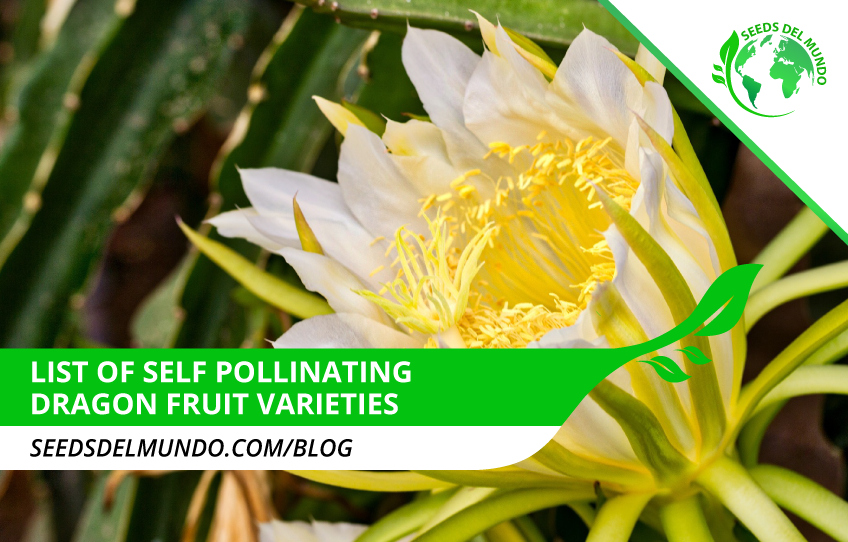Follow Us & be part of our Family
Which dragon fruits are self-pollinating and which need a hand from us or nature? What exactly is self-pollinating and does it have advantages and disadvantages? We will try to answer these frequently asked questions in our blog about self pollinating dragon fruit varieties. In addition, we have also listed the dragon fruit varieties that are self-fertile for you of course!
Self fertile dragon fruit vs self sterile dragon fruit
This is very useful to know, especially if you are just starting out. If you are interested in planting only 1 dragon fruit, a self-fertile dragon fruit is actually the best and easiest option. Do you want, or do you have several dragon fruit plants and do you want to grow fruit? Then you can get along well with both types. We have discussed the advantages and disadvantages for you below.
Self fertile (SF) pitaya
Means that the plant can use its own pollen to produce its own fruit. In this case, the anther containing pollen (the male) is close to the stigma (the female). Are you curious if your variety is self-fertile, yes or no? You can simply wait for this, since if your plant doesn’t bear fruit, you know what kind it is. With SF, therefore, there is no need for hand pollination or help from nature as the pollen will naturally hit the stigma due to gravity or the light movement of the flower itself. This will successfully pollinate it along the way.
Self sterile (SS) pitaya
Self sterile dragon fruits need a different dragon fruit variety pollen to produce fruits. In other words, if you have 1 dragon fruit plant that is self-sterile, it is advisable to take another variety if you want fruit of course. So you need different dragon fruit pollen to produce fruit.
White flesh dragon fruits tends to be more self-fertile than red flesh dragon fruits
Overview of self pollinating dragon fruits
There are of course many more self pollinating dragon fruit varieties, but we are proud to say that we have the following self pollinating dragon fruit plant for sale:
- American Beauty
- Dark star
- Delight
- Florida red
- Giant Vietnamese
- Hailey’s Comet
- Makisupa
- Rixford
- Seoul Kitchen
- Surinam Red
- Thai Dragon
- Thomson
- Vietnamese White
- Voodoo Child
- Wiangel
- Condor
- Natural Mystic
- Purple Haze
As you can see, we offer more self fertile dragon fruit varieties cuttings compared to self-sterile dragon fruit cuttings. Take a look at our range cuttings to find more cuttings we offer!
Best self fertile dragon fruits (super pollinators)
From the above list, we recommend the Vietnamese white. This plant is known for producing a lot of pollen and is categorized as one of the self pollinating dragon fruit varieties. Of course, several other factors play a role as well. The health of the plant is of course paramount. Because if that’s not good, the plant will never bear dragon fruit. So it’s all about the happiness of the plant.


Can I use cactus pollen to pollinate dragon fruit, cactus bloom in Feb-March I can save pollen
Hi Charlee,
You can use different variaties of Dragon Fruit plants or better said “the Pitaya variaties”. You can perfectly cross pollinate between other strings like the Stenocereus variaties and the Selenicereus variaties but you can’t use a “random” cactus that is not within the same “family”.
Is it safe to assume that the “Frieda’s Honey Yellow” dragon fruit from Costco are likely self-sterile? Sprouted some, learned about the fertility issue, and would like to get another kind if they are. Thank you for any insight!
“Frieda’s Honey Yellow” dragon fruit, is a type of Hylocereus undatus. This species of dragon fruit can indeed be self-sterile, meaning that it often requires cross-pollination from a different individual to produce fruit. But, not every plant will necessarily exhibit this sterility. Some might be self-fertile and can produce fruit on their own.
To maximize your chances of getting fruits, it’s a good idea to have more than one type of dragon fruit variety for pollination purposes. If you’ve sprouted “Frieda’s Honey Yellow,” you may consider acquiring another variety of dragon fruit to improve the chances of pollination and fruiting.
If you are considering growing another variety, some popular choices for cross-pollination with Hylocereus undatus include species like Hylocereus costaricensis and Hylocereus megalanthus. Remember also the following: Pitahaya plants typically bloom at night, so manual pollination (if necessary) would need to be done during the evening or very early morning.
While your “Frieda’s Honey Yellow” might be self-sterile, growing another variety alongside it can improve the chances of fruiting. If you’re passionate about growing dragon fruit, introducing another variety is a good way to ensure pollination and enjoy the fruiting process.
Hi, can I cross pollinate hylocereus undatus (red skin and white flesh) whit another hylocereus but whit red skin and red flesh?
Hi Geatano,
Yessss! You can cross-pollinate Hylocereus undatus (red skin with white flesh) with another Hylocereus species that has red skin and red flesh.
The Hylocereus species with red skin and red flesh is commonly known as Hylocereus costaricensis or sometimes as Hylocereus polyrhizus. Both belong to the same genus, so they can be cross-pollinated.
Good luck my friend!
can 2 diferrent self sterile pollinate each other??
Hi Mullo,
Yes, they can!
They can pollinate each other 🙂
With Tropical Greetings,
Wesley from SEEDS DEL MUNDO
Hello,
I recently found myself with some dragon fruit plants, but no information other than Hylocereus Polyrhizus, Red Flesh. I am trying to find out if that is a self pollinating, but it I can not seem to figure that out as Red Flesh is not the plants actual name. Would you be able to give me assistance with this?
Thanks
Hi Teresa,
This is indeed a difficult situation. If you buy something like this from us, you know what you are dealing with. You know exactly the kind of variety and the specs of every variety. A good tip for your situation right now would be to at least buy one self-polinating Dragon Fruit Plant (could be done in our Webshop or on DragonFruitCutting.com) so that this self pollinating variety can help to pollinate the others.
I wish you all the best of luck and if you have any more questions, feel free to reply to this again 🙂
With Love and Care,
SEEDS DEL MUNDO
Orejona Dragon Fruit Cactus (hylocereus polyrhizus)
Rare – The fruits produced by Orejona Dragon Fruit are deep red with red tips in color with a dark red, delicious flesh inside that is edible and earthy. Orejona is a wonderful mid-high yield, self pollinating variety, medium in size weighing on average 0.5 – 0.7 lbs. Easily adapted to a variety of growing conditions and soils, this beautiful night blooming cactus produces fruit best when allowed to climb on a burlap wrapped totem, trellis or your favorite tree. The huge 10-16 inch round flowers are highly fragrant and beautiful in form, usually lasting just one night.